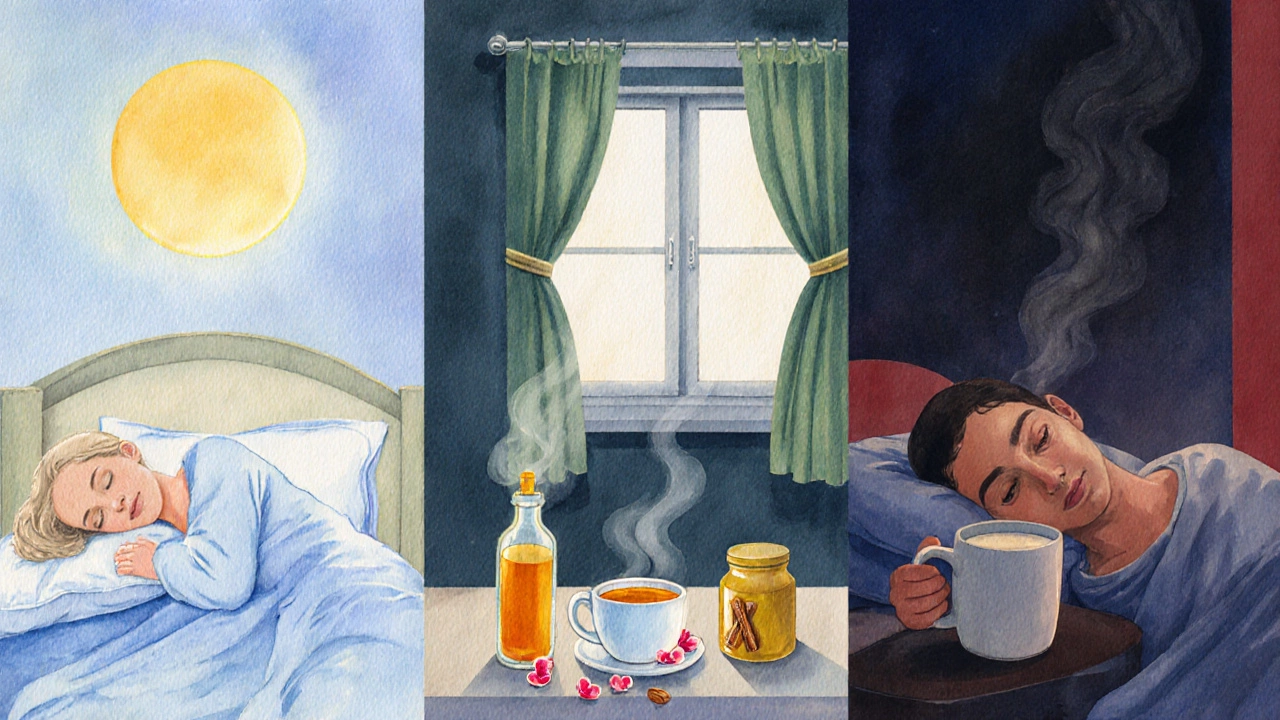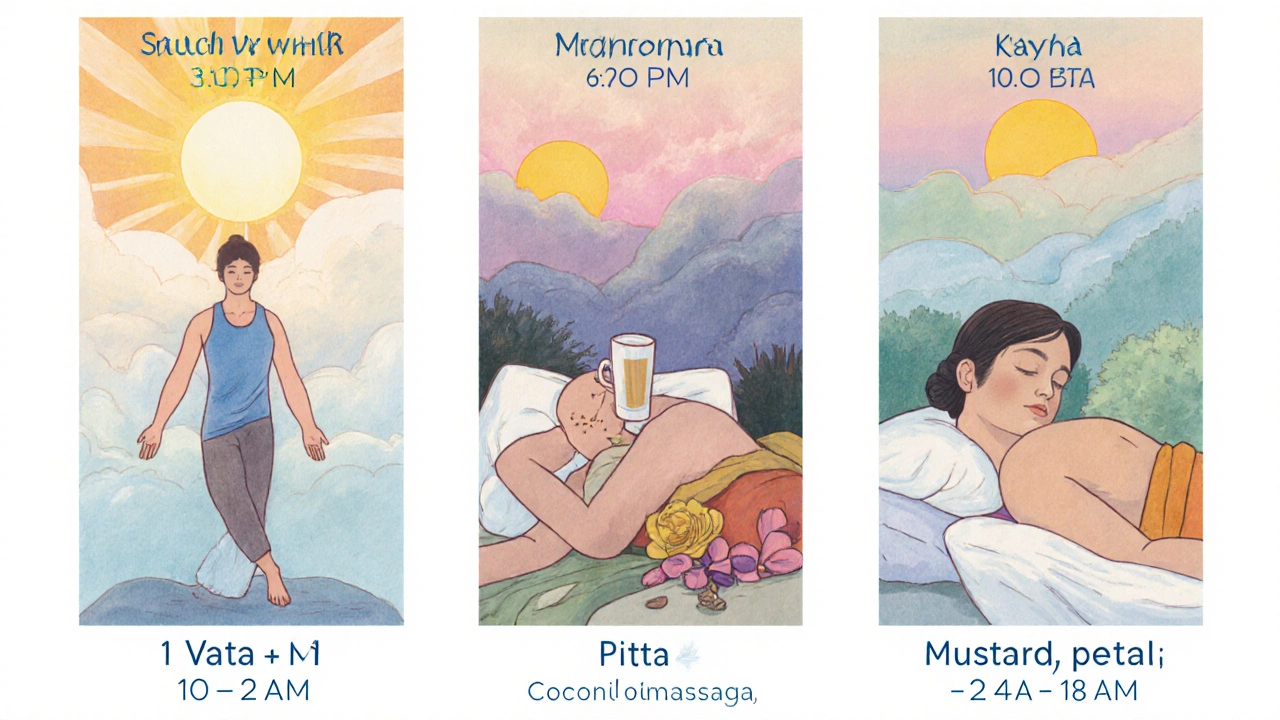- Home
- ::
- Optimal Sleep Times Based on Ayurveda: When to Rest for Each Dosha

Optimal Sleep Times Based on Ayurveda: When to Rest for Each Dosha
Most of us stare at the glowing screen until the early hours, then wonder why we feel groggy even after eight hours of sleep. What if the ancient science of Ayurveda had a simple answer - a daily clock that tells you exactly when to hit the pillow and when to rise? Below you’ll discover the Ayurvedic sleep schedule that aligns with your body constitution, practical steps to make it work, and how it stacks up against modern sleep advice.
Key Takeaways
- Ayurveda divides the 24‑hour day into three Dosha periods (Vata, Pitta, Kapha) that dictate optimal sleep windows.
- Vata types thrive on early‑night sleep (10pm-2am), Pitta on slightly later (11pm-3am), and Kapha on the deepest, late‑night window (12am-4am).
- Identify your dominant dosha through a quick questionnaire or lifestyle clues before setting your bedtime.
- Simple Ayurvedic rituals - oil massage, calming herbs, dim lighting - help signal the body that it’s time to rest.
- When you follow the Ayurvedic schedule, sleep quality improves, digestion steadies, and mental clarity rises, often without the need for sleep‑aid supplements.
What Ayurveda Says About Sleep
Ayurveda is a holistic healing system that originated in India over 5,000 years ago. It views health as a balance of three fundamental energies - Vata, Pitta and Kapha. These Dosha forces govern everything from digestion to mood, and even the timing of rest.
According to classic texts like the Charaka Samhita, each dosha has a peak period in the 24‑hour cycle, known as the panchamahabhuta rhythm. When you sleep during your dosha’s peak, the body can detoxify, rebuild tissue, and reset the nervous system with minimal effort. Miss the window, and you may feel restless, sore, or foggy the next day.
Ayurvedic Sleep Windows by Dosha
The three‑hour blocks below are the sweet spots for falling asleep. They are not strict cut‑offs; think of them as the most supportive windows.
| Dosha | Peak Sleep Window (Local Time) | Ideal Wake‑Up Time | Modern Suggested Window |
|---|---|---|---|
| Vata | 10pm-2am | 5am-7am | 10pm-12am |
| Pitta | 11pm-3am | 5am-7am | 11pm-1am |
| Kapha | 12am-4am | 6am-8am | 12am-2am |
Notice that all three doshas advise waking up around sunrise, a practice that mirrors modern circadian‑rhythm research. Speaking of which, the Ayurvedic concept of Circadian rhythm aligns closely with the dosha peaks, reinforcing why the ancient schedule still makes sense today.

How to Pinpoint Your Dominant Dosha for Sleep
Before you set your alarm, figure out which dosha governs your body‑mind makeup. Here’s a quick, no‑appointment quiz:
- Physical build: Light, slender frames often indicate Vata; medium, muscular builds hint at Pitta; larger, solid frames suggest Kapha.
- Temperament: If you’re creative, jumpy, and prone to anxiety, Vata reigns. If you’re ambitious, hot‑tempered, and competitive, you’re likely Pitta. If you’re calm, steady, and sometimes sluggish, Kapha may dominate.
- Digestive patterns: Irregular appetite and bloating = Vata; strong, steady appetite but prone to heartburn = Pitta; slow digestion and cravings for sweet, heavy foods = Kapha.
- Seasonal preference: Feel best in dry, cool weather? Vata. Prefer warm, dry climate? Pitta. Thrive in cool, moist weather? Kapka.
Most people have a primary dosha with secondary influences. If you’re a blend, aim for the middle of the two windows - for example, a Vata‑Pitta mix could target 10:30pm-2:30am.
Practical Steps to Align Your Sleep Schedule with Ayurveda
Once you know your window, follow these daily habits to make the transition smooth.
- Evening wind‑down (30‑60min before bed): Dim the lights, switch off electronic screens, and sip a warm cup of milk with a pinch of turmeric (Vata), herbal tea with rose petals (Pitta), or warm almond milk with cardamom (Kapha).
- Abhyanga (oil massage): Use sesame oil for Vata, coconut oil for Pitta, and mustard or almond oil for Kapha. Gently massage the scalp, arms, and legs to calm the nervous system.
- Bedroom environment: Keep the room cool (around 65‑68°F). Vata benefits from a slightly warmer, cozy setting, so add a soft blanket. Pitta prefers a cooler, airy space; use a fan or open window. Kapha enjoys a slightly warmer, darker room; blackout curtains work well.
- Breathing practice: Perform pranayama like Nadi Shodhana (alternate nostril breathing) for 5 minutes before sleep to balance the doshas.
- Ayurvedic herbs (if needed): Take a small dose of ashwagandha (Vata), brahmi (Pitta), or licorice root (Kapha) after consulting a qualified practitioner.
These rituals signal to the body's internal clock that bedtime is approaching, making it easier to fall asleep during the optimal window.
Signs Your Sleep Schedule Is Out of Sync
Ayurvedic texts list several red flags that indicate you’re missing the dosha sleep window:
- Vata imbalance: Restlessness, frequent waking, neck or joint pain.
- Pitta imbalance: Night sweats, irritability, feeling overheated.
- Kapha imbalance: Heavy‑headedness, oversleeping, sluggish digestion.
If you notice any of these patterns, adjust your bedtime by 30‑45minutes toward your dosha window and re‑introduce the evening rituals. Consistency over a week usually realigns the rhythm.

Ayurvedic Sleep Timing vs. Modern Sleep Recommendations
Western sleep science suggests 7‑9 hours of sleep for adults, with a focus on consistency. The Ayurvedic approach adds a layer of timing based on dosha peaks. Below is a side‑by‑side comparison:
| Aspect | Ayurvedic View | Modern Scientific View |
|---|---|---|
| Ideal Sleep Duration | 6‑8hours, aligned with dosha window | 7‑9hours for most adults |
| Bedtime Timing | Based on Vata/Pitta/Kapha peaks (10pm‑4am) | Consistent time, preferably before 11pm |
| Wake‑up Time | Near sunrise (5am‑8am) | Same hour daily, avoid oversleeping |
| Pre‑sleep Routine | Oil massage, herbal tea, breathing | Screen‑free, dim lighting, relaxed posture |
| Role of Food | Light, warm dinner; avoid heavy, oily foods 2‑3h before bed | Limit caffeine & heavy meals close to bedtime |
Both frameworks agree on the importance of regularity and avoiding stimulants. The Ayurvedic angle simply fine‑tunes the clock to your unique constitution, potentially offering a more personalized boost in sleep quality.
Putting It All Together: A Sample Day for Each Dosha
Below are three day‑plans that illustrate how to live in rhythm with your dosha‑based sleep window.
- Vata Day: Wake at 5:30am, gentle yoga, warm oatmeal, light lunch. Afternoon: creative work, short walk. Evening: light dinner by 7pm, sesame oil abhyanga at 9pm, herbal tea, lights dim at 9:30pm, sleep by 10pm.
- Pitta Day: Wake at 6am, brisk walk, fruit‑rich breakfast. Work with focused tasks until mid‑afternoon, cool water breaks. Dinner by 8pm, coconut oil massage at 10pm, rose‑petal tea, lights off by 10:30pm, sleep around 11pm.
- Kapha Day: Wake at 6:30am, brisk cardio, protein‑heavy breakfast. Light lunch, avoid heavy snacks. Early dinner (6pm), mustard oil massage at 11pm, warm almond milk, lights out by 12am, sleep until 4am.
Adjust the times slightly to fit your work schedule, but keep the core principle - sleep during your dosha peak - intact.
Frequently Asked Questions
Can I follow an Ayurvedic sleep schedule if I work night shifts?
Night‑shift workers can still honor dosha timing by creating a dark, cool sleep environment during the day and shifting their bedtime window forward. For example, a Kapha night‑shifter might aim to sleep from 8am-12pm, mirroring the natural Kapha peak after sunrise.
What if my dosha changes with the seasons?
Ayurveda acknowledges seasonal shifts (Ritucharya). If you move from a hot summer (Pitta‑dominant) to a cool winter (Vata‑dominant), gently adjust your bedtime earlier by 30‑45minutes and re‑introduce Vata‑balancing rituals like warm oil massage.
Do I need to take herbal supplements to make this work?
Supplements are optional. Most people achieve better sleep simply by aligning bedtime, using calming breathwork, and following the evening oil‑massage routine. If you have chronic insomnia, consult an Ayurvedic practitioner before adding herbs.
How does Ayurveda explain why I feel groggy when I wake up after 5am?
Waking before the body has completed a full sleep cycle (approximately 90 minutes) can leave you in a lighter sleep stage. In Ayurvedic terms, the dosha hasn’t fully detoxified, leading to vata‑induced fatigue. Aim to wake after a complete 6‑hour block within your dosha window.
Is the Ayurvedic sleep schedule safe for children?
Children have faster metabolic rates, so they usually benefit from going to bed slightly earlier than adults. Follow the same dosha windows but add 30‑45minutes of extra sleep, and keep the evening routine gentle and play‑free.

 Health and Wellness
Health and Wellness





Write a comment